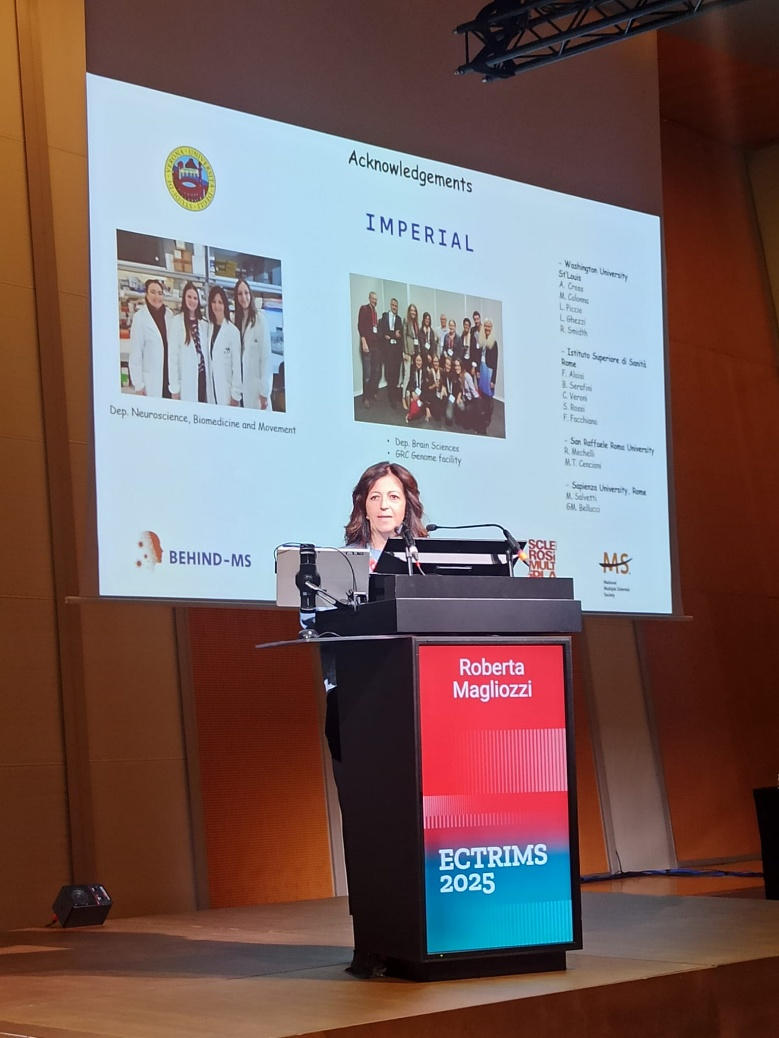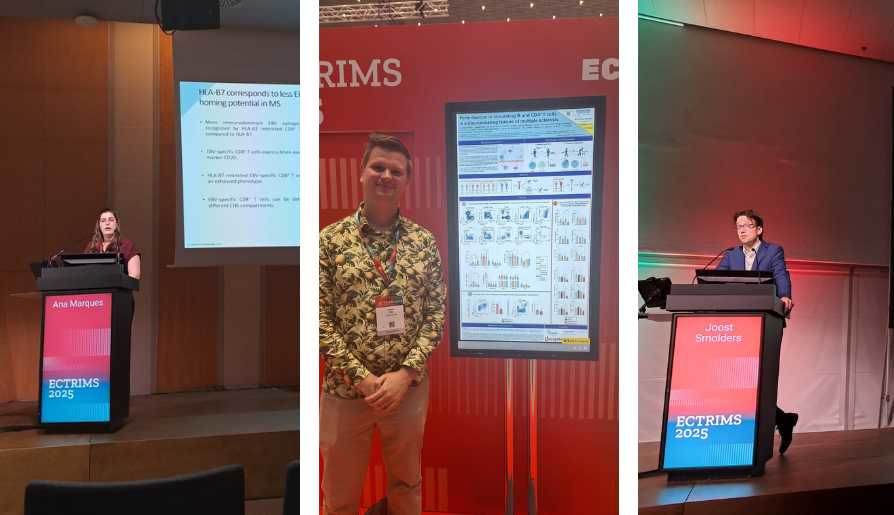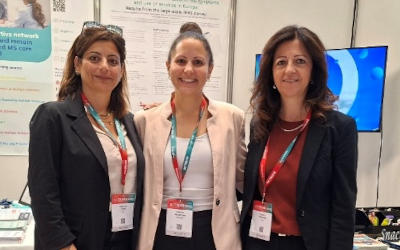BEHIND-MS at ECTRIMS 2025
Advancing the Understanding of Epstein-Barr Virus in Multiple Sclerosis
Posted on October 28, 2025 • 6 minutes • 1079 words
Table of contents
At this year’s ECTRIMS Congress in Barcelona (24–26 September 2025), the EU Horizon-funded consortia BEHIND-MS made a powerful contribution to advancing our understanding of the Epstein-Barr virus (EBV) and its potential role in multiple sclerosis (MS). Through a series of oral and poster presentations, educational sessions, and collaborative meetings, BEHIND-MS researchers shared groundbreaking findings that shed light on how EBV infection, immune dysregulation, and genetic susceptibility intersect in MS. The consortium’s strong presence at ECTRIMS highlighted not only scientific excellence but also the importance of collaboration across Europe to accelerate discovery and move closer to prevention and better outcomes for people with MS.

Figure 1. Dr. Caterina Veroni presenting her poster at ECTRIMS 2025.
Genetic Susceptibility and Viral Reactivation: Insights from Caterina Veroni
Dr. Caterina Veroni, from Istituto Superiore di Sanità (ISS), and her team investigated the interplay between EBV infection and the BAFF-var genetic variant, which is linked to increased MS risk and influences B-cell survival - the main reservoir for EBV.
Their study compared people with MS (PwMS) and healthy donors, analyzing antibody responses to EBV, viral DNA and RNA, BAFF-var genotype, soluble BAFF levels, and BAFF-related gene expression. PwMS showed higher EBV antibody levels and more frequent viral DNA and RNA detection, indicating enhanced viral activity. Among BAFF-var carriers, elevated antibody levels together with viral and immune activation markers pointed to a shift toward EBV reactivation.
These results support the hypothesis that impaired EBV control contributes to MS and that BAFF-var may amplify this effect, positioning the BAFF/APRIL axis as a promising target for future therapies, particularly in a subgroup of patients carrying this genetic variant.

Figure 2. Dr. Roberta Magiolizzi presenting at ECTRIMS 2025.
EBV in the Brain: Findings from Prof. Roberta Magliozzi
Prof. Roberta Magliozzi, from the University of Verona (UNIVR), presented novel evidence of proliferating B cells expressing latent EBV antigens (specifically EBNA2) in the meninges of post-mortem MS brains. Her team observed correlations between these EBNA2⁺ cells, meningeal lymphoid-like structures, and more severe disease progression.
They also identified a distinctive proteomic signature in cerebrospinal fluid (CSF) samples from these cases, marked by elevated inflammatory mediators such as LTa, CD21, and specific immunoglobulins (IgM, IgK). These findings suggest that latent EBV infection can drive continuous B-cell expansion within the brain, even in progressive MS, and that this process could represent a potential new therapeutic target and may be detectable through CSF biomarkers - offering a potential tool for monitoring intrathecal EBV infection.

Figure 3. Prof. Luenemann presenting at the educational session at ECTRIMS 2025.
Understanding EBV’s Role in Immune Dysregulation: Prof. Jan Lünemann’s Session
In a joint educational session on EBV and MS, Prof. Jan Lünemann, University of Münster, guided attendees through the biology of EBV infection and its effects on B and T cells. Together with Prof. Cortese and Prof. Torkildsen from the EBV-MS consortium , he explored how molecular mimicry - where viral proteins resemble self-proteins - might trigger autoimmune responses.
Prof. Lünemann’s presentation emphasized BEHIND-MS’s central goal: uncovering the mechanisms linking EBV to MS through collaborative, multidisciplinary research. His talk bridged the gap between molecular findings and clinical implications, reinforcing the need for shared efforts across research consortia.

Figure 4. From left to right: Dr. Ana Marques, Dr. Jasper Rip, and Dr. Joost Smolders
New Discoveries from Erasmus MC: The Dutch Team’s Contributions
HLA Class I Alleles and Exhausted CD8⁺ T Cells – Dr. Ana Marques, Erasmus MC
Dr. Ana Marques presented evidence that MS-associated HLA class I alleles shape the CD8⁺ T-cell response to EBV. Her team found that HLA-B7-restricted EBV-specific CD8⁺ T cells are more confined and show an exhausted and brain-residency phenotype that corresponded to anti-EBV antibody titers. These findings suggest a reduced capacity to control EBV infection and a possible link to MS susceptibility.
B and T Cell Changes in Early MS – Optic Neuritis Study
In a separate ePoster, researchers analyzed individuals with and without MS after experiencing optic neuritis, using extremes in anti-EBV antibody titers and genetic risk scores to reveal early immune alterations. They observed distinct B- and T-cell shifts in high-risk individuals, underlining the role of previously identified subsets that are associated with EBV and eventually drive antibody production within the brain during MS development.
Integrin β1 and Brain-Resident Antibody-Secreting Cells – Dr. Joost Smolders, Erasmus MC
Prof. Joost Smolders presented cutting-edge work showing that integrin β1 (CD29) together with CXCR3 marks circulating B cells that become antibody-secreting cells within the MS brain MS. This coexpression was not seen on circulating antibody-secreting cells. Notably, CD29 has been described to increase the susceptibility of B cells to an EBV infection. His team also found that after T-cell help, CD29 is upregulated on circulating CXCR3⁺ B cells from people with MS, including those who showed disease recurrence after cladribine treatment - making it a potential biomarker for MS activity.
CD4⁺ Cytotoxic Precursors and B/T Cell Perturbances – Dr. Jasper Rip, Erasmus MC
Dr. Jasper Rip and his team identified a CD4⁺ cytotoxic T-cell precursor with strong brain affinity in people with MS, offering insight into how these cells may breach the blood-brain barrier to contribute to neuroinflammation. His additional work showed that B- and CD4⁺ T-cell alterations in the blood from people with MS are disease-specific, distinguishing MS from other CNS autoimmune disorders and marking the progressive nature of MS based on the presence of CXCR3+ B cells.
Collaboration and Brain Research
During ECTRIMS, Patricia Moghames (European Multiple Sclerosis Platform), Caterina Veroni (ISS), and Roberta Magliozzi (UNIVR) came together to discuss the significance of brain health and brain tissue research in understanding MS. They highlighted how brain banks play a crucial role in advancing science, and how donation to research transforms personal legacy into lasting scientific impact.
Their meeting reflected the collaborative spirit of the BEHIND-MS consortium, uniting scientists, clinicians, and patient advocates to translate research into real-world progress for the MS community.

Figure 5. From left to right: Dr. Caterina Veroni, Patricia Moghames, Dr. Roberta Magliozzi at EMSP’s booth at ECTRIMS 2025
Collaboration Driving Discovery
The BEHIND-MS consortium’s presence at ECTRIMS 2025 showcased the power of collaboration in decoding the relationship between EBV and multiple sclerosis. By connecting genetic, viral, and immunological insights, consortium members are paving the way for the development of biomarkers, preventive approaches, and targeted therapies that could reshape MS care.
Through shared dedication and innovation, BEHIND-MS continues to push the boundaries of what’s possible - bringing hope for a future where MS can be better understood, prevented, and treated.
